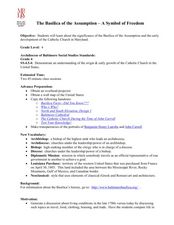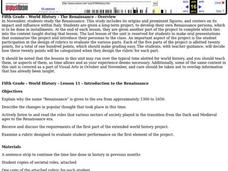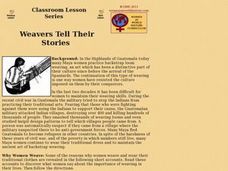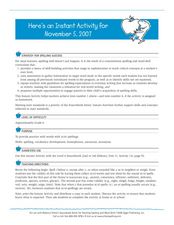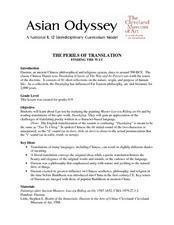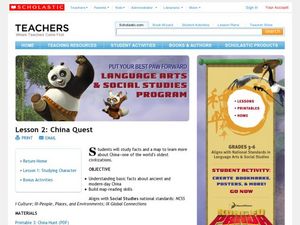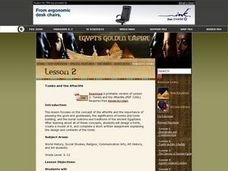Curated OER
The Basilica of the Assumption-A Symbol of Freedom
Fourth graders explore the importance of the Basilica of Assumption and the development of the Catholic Church in Maryland. In this social studies lesson, 4th graders discuss the Basilica of the Assumption and the Catholic Church.
Curated OER
Fujiyama
Students examine and discuss Mt. Fuji (Fujiyama) and its effect on the culture and philosophy of Japan. This high school lesson is ideal for a Social Studies, Humanities, or Asian Studies class.
Curated OER
Exercise for Writing a Summary Paragraph
High schoolers examine how to write article summaries of abstracts. In this writing skills lesson, students edit the noted sections of an abstract that is already written on the Old Testament Abstracts.
Curated OER
The Renaissance
Fifth graders examine the rise of the Renaissance and the contributions and roles of various groups such as ancient Greeks, Muslim scholars, the aristocracy, the Catholic Church, and tradesmen. They develop and write a report on a...
Curated OER
Weavers Tell Their Stories
Learners examine the practice of weaving by Mayan women. They read personal accounts and write a sentence stating the main idea. They also write a short report on weaving as a cultural and economic way of life for the Mayan women.
Curated OER
Pendemonium: The Italian Job
Students identify prefixes, roots, and suffixes. In this grammar rules lesson, students analyze word parts to determine the meaning of unfamiliar words.
Curated OER
Sea Turtle
Students listen to a story about a sea turtle sanctuary. They participate in a discussion about the sea turtles. They analyze some of the hazards that can hurt sea turtles and brainstorm ways to help the problem. They write and...
Curated OER
Someone Like Me
Students investigate what sort of person the author is. They listen as the teacher use her notes to introduce Tom Holt briefly. Students are asked if anyone has read any of his books. They work in pairs to find more about Tom Holt as a...
Curated OER
Here's an Instant Activity for November 5, 2007
Students improve their spelling skills by completing activities for homophones, antonyms, and synonyms. Students complete a spelling worksheet for 'ie' and 'ei' words. Students then identify 12 homophones, 12 antonyms, and 12 synonyms.
Curated OER
Destruction in Bamiyan
Students examine the destruction of the colossal statues of Buddha, carved into sandstone cliffs of Bamiyan, Afghanistan, that were recently demolished by the Taleban. They look for photos of local artifacts that represent the culture...
Curated OER
The Perils of Translation
Pupils discover the challenges of translating poetry written in a character-based language through the study of Lao-tzu's work, Daodejing. This lesson plan includes possible extensions and evaluations.
Curated OER
Using Women's Words
Students examine quotes from women and choose one that appeals to them. They research the woman and answer questions related to her. They are to find other quotes that interest them.
Curated OER
China Quest
Read and research information on China. Young researchers complete a knowledge hunt about China then locate and describe each location using directional words. They recognize the word meaning through context clues and application practice.
Curated OER
Tour Of South America
Students explore South America. For this geography lesson, students research landmarks of historical or national significance and use their findings to create slideshows.
Curated OER
What Kind of Vessel Are You?
This is a strange question; but what kind of vessel would you be and why? After examining images of a large Inca jug, the class sets to writing a creative narrative that answers that very interesting question. They start by researching...
Curated OER
New Perspectives
Eighth graders imagine they are getting ready to "take off." They may imagine themselves in any type of aircraft or spaceship. They may then sketch themselves as passengers anticipating this moment.
Curated OER
Hungary: The Landscape
Students work in small groups to create a topographic map of Hungary. The map will include labeled line drawing of the bordering countries. Hungary should be three dimensional, made of salt and flour clay. The mountains, plains and...
Curated OER
Tombs and the Afterlife
Students design a tomb, create a model of it, and complete a short written assignment explaining the design and contents of the tomb. They study the concept of the afterlife and the importance of pleasing the gods and goddesses.
Curated OER
Rockin? Chalk (Integrating science - make own chalk)
Students use plaster of Paris, talc, and cornstarch to create their own chalk. They hypothesize what mixture of ingredients produce the "best" chalk. Students discuss what they think are the characteristics of the "best" chalk.
Curated OER
Come On Over To Maya Place
Fifth graders analyze the Mayan culture. In this Mayan culture instructional activity, 5th graders study the Mayan culture noting similarities and differences between the Mayan culture and their own. Students examine hieroglyphic writing...
Curated OER
Let's Go To Mexico
Students are able to use the Internet to conduct research. They research Mexican culture and traditions. Students compare and contrast Mexican and U.S. food and clothing. They convert United States currency to Mexican pesos. Students...
Curated OER
Make Your Own Petroglyph!
Learners create their own petroglyph. In this petroglyph instructional activity, students study and compare various petroglyphs. They create their own petroglyph to symbolize the seasons.
Curated OER
China: How to Put Some "Tang" in Your Medieval Dynasties
Fourth graders label the countries that border China and the physical features of Asia. They discuss the physical features of Asia and label them on the other map.
Curated OER
Aztec and Mayan Mythology
Sixth graders write myths to show tolerance in creation. They read from both the Aztec and Mayan eras and develop an understanding of the similarities and differences of these two closely related cultures. They track the travels of...


